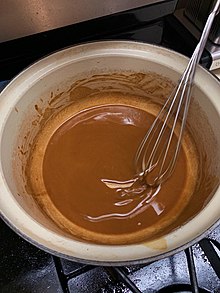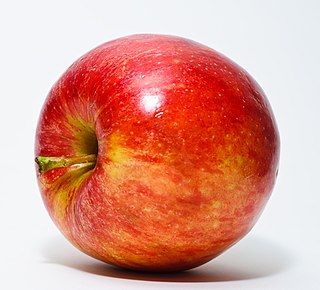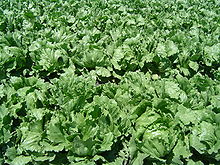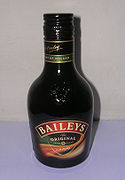Portal:Food
F o o d
A portal dedicated to food and foodways
Introduction


Food is any substance consumed by an organism for nutritional support. Food is usually of plant, animal, or fungal origin and contains essential nutrients such as carbohydrates, fats, proteins, vitamins, or minerals. The substance is ingested by an organism and assimilated by the organism's cells to provide energy, maintain life, or stimulate growth. Different species of animals have different feeding behaviours that satisfy the needs of their metabolisms and have evolved to fill a specific ecological niche within specific geographical contexts.
Omnivorous humans are highly adaptable and have adapted to obtain food in many different ecosystems. Humans generally use cooking to prepare food for consumption. The majority of the food energy required is supplied by the industrial food industry, which produces food through intensive agriculture and distributes it through complex food processing and food distribution systems. This system of conventional agriculture relies heavily on fossil fuels, which means that the food and agricultural systems are one of the major contributors to climate change, accounting for as much as 37% of total greenhouse gas emissions. (Full article...)
Cooking, also known as cookery or professionally as the culinary arts, is the art, science and craft of using heat to make food more palatable, digestible, nutritious, or safe. Cooking techniques and ingredients vary widely, from grilling food over an open fire, to using electric stoves, to baking in various types of ovens, reflecting local conditions.
Preparing food with heat or fire is an activity unique to humans. Archeological evidence of cooking fires from at least 300,000 years ago exists, but some estimate that humans started cooking up to 2 million years ago.
The expansion of agriculture, commerce, trade, and transportation between civilizations in different regions offered cooks many new ingredients. New inventions and technologies, such as the invention of pottery for holding and boiling of water, expanded cooking techniques. Some modern cooks apply advanced scientific techniques to food preparation to further enhance the flavor of the dish served. (Full article...)

French fries (North American English), chips (British English and other national varieties), finger chips (Indian English), french-fried potatoes, or simply fries are batonnet or allumette-cut deep-fried potatoes of disputed origin from Belgium or France. They are prepared by cutting potatoes into even strips, drying them, and frying them, usually in a deep fryer. Pre-cut, blanched, and frozen russet potatoes are widely used, and sometimes baked in a regular or convection oven; air fryers are small convection ovens marketed for frying potatoes.
French fries are served hot, either soft or crispy, and are generally eaten as part of lunch or dinner or by themselves as a snack, and they commonly appear on the menus of diners, fast food restaurants, pubs, and bars. They are often salted and may be served with ketchup, vinegar, mayonnaise, tomato sauce, or other sauces. Fries can be topped more heavily, as in the dishes of poutine, loaded fries or chili cheese fries. French fries can be made from sweet potatoes instead of potatoes. A baked variant, oven fries, uses less or no oil. (Full article...)
Selected article –

Selected cuisine -

Italian-American cuisine (Italian: cucina italoamericana) is a style of Italian cuisine adapted throughout the United States. Italian-American food has been shaped throughout history by various waves of immigrants and their descendants, called Italian Americans.
As immigrants from the different regions of Italy settled throughout the various regions of the United States, many brought with them a distinct regional Italian culinary tradition. Many of these foods and recipes developed into new favorites for the townspeople and later for Americans nationwide. (Full article...)Selected ingredient –

Sucrose, a disaccharide, is a sugar composed of glucose and fructose subunits. It is produced naturally in plants and is the main constituent of white sugar. It has the molecular formula C
12H
22O
11.
For human consumption, sucrose is extracted and refined from either sugarcane or sugar beet. Sugar mills – typically located in tropical regions near where sugarcane is grown – crush the cane and produce raw sugar which is shipped to other factories for refining into pure sucrose. Sugar beet factories are located in temperate climates where the beet is grown, and process the beets directly into refined sugar. The sugar-refining process involves washing the raw sugar crystals before dissolving them into a sugar syrup which is filtered and then passed over carbon to remove any residual colour. The sugar syrup is then concentrated by boiling under a vacuum and crystallized as the final purification process to produce crystals of pure sucrose that are clear, odorless, and sweet. (Full article...)
Selected recipe –

Roux (/ruː/) is a mixture of flour and fat cooked together and used to thicken sauces. Roux is typically made from equal parts of flour and fat by weight. The flour is added to the melted fat or oil on the stove top, blended until smooth, and cooked to the desired level of brownness. A roux can be white, blond (darker) or brown. Butter, bacon drippings or lard are commonly used fats. Roux is used as a thickening agent for gravy, sauces, soups and stews. It provides the base for a dish, and other ingredients are added after the roux is complete. (Full article...)
Lettuce (Lactuca sativa) is an annual plant of the family Asteraceae. It is most often grown as a leaf vegetable, but sometimes for its stem and seeds. Lettuce is most often used for salads, although it is also seen in other kinds of food, such as soups, sandwiches and wraps; it can also be grilled. One variety, celtuce (asparagus lettuce), is grown for its stems, which are eaten either raw or cooked. In addition to its main use as a leafy green, it has also gathered religious and medicinal significance over centuries of human consumption. Europe and North America originally dominated the market for lettuce, but by the late 20th century the consumption of lettuce had spread throughout the world. , world production of lettuce and chicory was 27 million tonnes, 53 percent of which came from China.
Lettuce was originally farmed by the ancient Egyptians, who transformed it from a plant whose seeds were used to obtain oil into an important food crop raised for its succulent leaves and oil-rich seeds. Lettuce spread to the Greeks and Romans; the latter gave it the name lactuca, from which the English lettuce is derived. By 50 AD, many types were described, and lettuce appeared often in medieval writings, including several herbals. The 16th through 18th centuries saw the development of many varieties in Europe, and by the mid-18th century, cultivars were described that can still be found in modern gardens. (Full article...)Selected image –

Selected biography –

B. June 25, 1956 – d. June 8, 2018
Anthony Michael Bourdain (/bɔːrˈdeɪn/; June 25, 1956 – June 8, 2018) was an American celebrity chef, author, and travel documentarian. He starred in programs focusing on the exploration of international culture, cuisine, and the human condition.
Bourdain was a 1978 graduate of The Culinary Institute of America and a veteran of many professional kitchens during his career, which included several years spent as an executive chef at Brasserie Les Halles, in Manhattan. He first became known for his bestselling book Kitchen Confidential: Adventures in the Culinary Underbelly (2000). (Full article...)
Did you know (auto-generated) –

- ... that Ice Spice is Princess Diana?
- ... that some fans of Genshin Impact have referred to the character Paimon as "emergency food"?
- ... that after George Alexander Albrecht collapsed when conducting Beethoven's Ninth Symphony during a New Year's concert, he returned to composing and began hospice work?
- ... that during the 2021 food crisis in southern Madagascar, people have resorted to eating things such as raw red cactus fruits, wild leaves, locusts, ashes mixed with tamarind, and shoe leather?
- ... that by 1967, staff at the Home Office were told not to feed Peta morsels of food as she had become "inordinately fat"?
- ... that an investigation found that most Mexican nutrition science students could not interpret a nutritional front-of-package labeling system correctly?
More did you know –
Related portals
Food topics
The following are topics relating to food
Categories
Food list articles
- See also: Lists of foods and Category:Lists of drinks
The following are some Food list articles on Wikipedia:

- American cheeses
- Appellation d'Origine Contrôlée cheeses
- Apple cultivars
- Bacon dishes
- Bacon substitutes
- Basil cultivars
- Breads
- Breakfast beverages
- Breakfast cereals
- Breakfast foods
- British cheeses
- Cakes
- Candies
- Cheeses
- Cheese soups
- Christmas dishes (list)
- Cocktails
- Cookies
- Dishes using coconut milk
- Diets
- Doughnut varieties
- Egg dishes
- Fermented soy products
- Food additives
- Food additives (Codex Alimentarius)
- Foods named after people
- French cheeses
- French dishes
- Fried dough foods
- Fruits
- List of hamburgers
- Herbs and spices
- Hors d'oeuvre
- Indian dishes
- Indian snack foods
- Indonesian dishes
- Italian dishes
- Japanese snacks
- Japanese dishes
- Jewish dishes
- Kebabs
- Korean beverages
- Mango cultivars
- Moroccan dishes
- Pasta
- Pastries
- Philippine snack food
- Pies, tarts and flans
- Poppy seed pastries and dishes
- Potato dishes
- Puddings
- Raw fish dishes
- Rice dishes
- Rolled foods
- Sauces
- Seafood
- Seeds
- Sandwiches
- Snack foods
- Soft drinks by country
- Soul foods and dishes
- Soups
- Stews
- Street foods
- Tapas
- Turkish dishes
- Twice-baked foods
- Vegetable oils
- Vegetables
- Vodkas
Things you can do
Related WikiProjects
| Parent project: WikiProject Food and Drink | |
| Child projects: | Task forces: (All inactive) |
|
|
| Related projects: | |
New articles
Rules | Match log | Results page (for watching) | Last updated: 2024-04-30 19:18 (UTC)
Note: The list display can now be customized by each user. See List display personalization for details.
- Koffi (restaurant) (edit | talk | history | links | watch | logs | tools) by Another Believer (talk · contribs · new pages (158)) started on 2024-04-30, score: 10
- H. Avard Loomer (edit | talk | history | links | watch | logs | tools) by B3251 (talk · contribs · new pages (29)) started on 2024-04-30, score: 10
- Sherman's Deli & Bakery (edit | talk | history | links | watch | logs | tools) by Another Believer (talk · contribs · new pages (158)) started on 2024-04-30, score: 10
- Paul B. Wishart (edit | talk | history | links | watch | logs | tools) by Dmarsch (talk · contribs · new pages (5)) started on 2024-04-29, score: 10
- Meat water holding capacity (edit | talk | history | links | watch | logs | tools) by GobsPint (talk · contribs · new pages (140)) started on 2024-04-29, score: 10
- Meat diaper (edit | talk | history | links | watch | logs | tools) by GobsPint (talk · contribs · new pages (140)) started on 2024-04-29, score: 20
- Localis (restaurant) (edit | talk | history | links | watch | logs | tools) by Another Believer (talk · contribs · new pages (158)) started on 2024-04-29, score: 10
- Waxi's (edit | talk | history | links | watch | logs | tools) by Jacobo Marcus Galicia (talk · contribs · new pages (1)) started on 2024-04-25, score: 10
- Westman's Bagel & Coffee (edit | talk | history | links | watch | logs | tools) by Another Believer (talk · contribs · new pages (158)) started on 2024-04-19, score: 10
- Kōki Saitō (edit | talk | history | links | watch | logs | tools) by Cynikles (talk · contribs · new pages (1)) started on 2024-04-29, score: 10
- 24 in 24: Last Chef Standing (edit | talk | history | links | watch | logs | tools) by TristanQuinn (talk · contribs · new pages (2)) started on 2024-04-29, score: 10
- La Mejor Bakery (edit | talk | history | links | watch | logs | tools) by BaduFerreira (talk · contribs · new pages (10)) started on 2024-04-29, score: 20
- Wilson Davis (edit | talk | history | links | watch | logs | tools) by Vycl1994 (talk · contribs · new pages (18)) started on 2024-04-28, score: 10
- Sweet Rose Creamery (edit | talk | history | links | watch | logs | tools) by TrademarkedTWOrantula (talk · contribs · new pages (5)) started on 2024-04-28, score: 10
- Hunters Palm Springs (edit | talk | history | links | watch | logs | tools) by Another Believer (talk · contribs · new pages (158)) started on 2024-04-28, score: 10
- Haitian spaghetti (edit | talk | history | links | watch | logs | tools) by Valereee (talk · contribs · new pages (8)) started on 2024-04-27, score: 10
- Artocarpus styracifolius (edit | talk | history | links | watch | logs | tools) by Ulathijau (talk · contribs · new pages (2)) started on 2024-04-27, score: 10
- Atomo (edit | talk | history | links | watch | logs | tools) by White 720 (talk · contribs · new pages (2)) started on 2024-04-27, score: 30
- Lauren Rudolph E. coli case (edit | talk | history | links | watch | logs | tools) by Margaretdonnelly (talk · contribs · new pages (1)) started on 2024-04-23, score: 10
- Ruditapes philippinarum (edit | talk | history | links | watch | logs | tools) by Sjl197 (talk · contribs · new pages (1)) started on 2024-04-27, score: 10
- Bonèt (edit | talk | history | links | watch | logs | tools) by Frankserafini87 (talk · contribs · new pages (3)) started on 2024-04-26, score: 20
- Ganmianpi (edit | talk | history | links | watch | logs | tools) by Iuliusnanus (talk · contribs · new pages (8)) started on 2024-04-25, score: 10
- D'Ambrosio Gelato (edit | talk | history | links | watch | logs | tools) by Another Believer (talk · contribs · new pages (158)) started on 2024-04-25, score: 10
- Murcian meat pie (edit | talk | history | links | watch | logs | tools) by ChampClancy (talk · contribs · new pages (1)) started on 2024-04-24, score: 20
- Full Tilt Ice Cream (edit | talk | history | links | watch | logs | tools) by Another Believer (talk · contribs · new pages (158)) started on 2024-04-24, score: 10
- Roger Hugo (edit | talk | history | links | watch | logs | tools) by NouveauSarfas (talk · contribs · new pages (1)) started on 2024-04-24, score: 10
- Gelatiamo (edit | talk | history | links | watch | logs | tools) by Another Believer (talk · contribs · new pages (158)) started on 2024-04-24, score: 10
- Paratrophis banksii (edit | talk | history | links | watch | logs | tools) by Tom Radulovich (talk · contribs · new pages (155)) started on 2024-04-23, score: 10
- Dumb bread (edit | talk | history | links | watch | logs | tools) by LittleT889 (talk · contribs · new pages (12)) started on 2024-04-23, score: 10
- Frankie & Jo's (edit | talk | history | links | watch | logs | tools) by Another Believer (talk · contribs · new pages (158)) started on 2024-04-23, score: 10
- List of food and drink monuments (edit | talk | history | links | watch | logs | tools) by Altenmann (talk · contribs · new pages (77)) started on 2024-04-23, score: 20
- Ko Omm (edit | talk | history | links | watch | logs | tools) by Sattwaikyaw (talk · contribs · new pages (1)) started on 2024-04-22, score: 10
- Nourishing Hope (edit | talk | history | links | watch | logs | tools) by Raearutherford (talk · contribs · new pages (1)) started on 2024-04-16, score: 10
- Rachel's Ginger Beer (edit | talk | history | links | watch | logs | tools) by Another Believer (talk · contribs · new pages (158)) started on 2024-04-22, score: 10
- Crisp pork (edit | talk | history | links | watch | logs | tools) by チャリス (talk · contribs · new pages (8)) started on 2024-04-22, score: 20
- "Flower" tofu (edit | talk | history | links | watch | logs | tools) by チャリス (talk · contribs · new pages (8)) started on 2024-04-22, score: 10
- Taro pastry (edit | talk | history | links | watch | logs | tools) by Heeheemalu (talk · contribs · new pages (14)) started on 2024-04-22, score: 10
- Garbage Plate (edit | talk | history | links | watch | logs | tools) by BanjoZebra (talk · contribs · new pages (5)) started on 2024-04-10, score: 40
- Morning in America (EP) (edit | talk | history | links | watch | logs | tools) by OttoJohn (talk · contribs · new pages (1)) started on 2024-04-21, score: 10
- Mike's Hot Honey (edit | talk | history | links | watch | logs | tools) by BanjoZebra (talk · contribs · new pages (5)) started on 2024-04-21, score: 40
- Zajiangmian (edit | talk | history | links | watch | logs | tools) by チャリス (talk · contribs · new pages (8)) started on 2024-04-21, score: 20
- Cannabis in the restaurant industry (edit | talk | history | links | watch | logs | tools) by Another Believer (talk · contribs · new pages (158)) started on 2024-04-21, score: 10
- Kentrell Barkley (edit | talk | history | links | watch | logs | tools) by Skyggestadium (talk · contribs · new pages (7)) started on 2024-04-21, score: 10
- Coffee Talk Episode 2: Hibiscus & Butterfly (edit | talk | history | links | watch | logs | tools) by JuniperChill (talk · contribs · new pages (12)) started on 2024-04-20, score: 20
- Dough Joy (edit | talk | history | links | watch | logs | tools) by Another Believer (talk · contribs · new pages (158)) started on 2024-04-20, score: 20
- Chicken galantina (edit | talk | history | links | watch | logs | tools) by Obsidian Soul (talk · contribs · new pages (36)) started on 2024-04-19, score: 20
- Ponche Navideño (edit | talk | history | links | watch | logs | tools) by Valereee (talk · contribs · new pages (8)) started on 2024-04-19, score: 20
- Lengua estofado (edit | talk | history | links | watch | logs | tools) by Obsidian Soul (talk · contribs · new pages (36)) started on 2024-04-19, score: 20
- PDX671 (edit | talk | history | links | watch | logs | tools) by Another Believer (talk · contribs · new pages (158)) started on 2024-04-19, score: 10
- Organic market in Ukraine (edit | talk | history | links | watch | logs | tools) by QFTP2024 (talk · contribs · new pages (1)) started on 2024-04-16, score: 10
- Taqua banana (edit | talk | history | links | watch | logs | tools) by Fredo.fernando (talk · contribs · new pages (1)) started on 2024-04-18, score: 10
- Butifarra (sandwich) (edit | talk | history | links | watch | logs | tools) by Tony24644 (talk · contribs · new pages (6)) started on 2024-04-18, score: 10
- Kuai Kuai (edit | talk | history | links | watch | logs | tools) by Heeheemalu (talk · contribs · new pages (14)) started on 2024-04-17, score: 20
- Rocklands Barbeque and Grilling Company (edit | talk | history | links | watch | logs | tools) by DarkNight0917 (talk · contribs · new pages (7)) started on 2024-04-17, score: 10
- Sweet Alchemy (edit | talk | history | links | watch | logs | tools) by Another Believer (talk · contribs · new pages (158)) started on 2024-04-16, score: 10
- Diet Coke (edit | talk | history | links | watch | logs | tools) by 99.196.135.213 (talk · contribs · new pages (1)) started on 2024-04-16, score: 20
- The Lakes Distillery (edit | talk | history | links | watch | logs | tools) by ChefBear01 (talk · contribs · new pages (5)) started on 2024-04-16, score: 20
- Cully & Sully (edit | talk | history | links | watch | logs | tools) by Liz (talk · contribs · new pages (88)) started on 2024-04-16, score: 30
- Trine Lotherington Danielsen (edit | talk | history | links | watch | logs | tools) by Geschichte (talk · contribs · new pages (24)) started on 2024-04-16, score: 10
- Medical Device User Fee and Modernization Act (edit | talk | history | links | watch | logs | tools) by GobsPint (talk · contribs · new pages (140)) started on 2024-04-16, score: 10
- Uneeda Biscuit (edit | talk | history | links | watch | logs | tools) by CNMall41 (talk · contribs · new pages (21)) started on 2024-04-10, score: 30
Associated Wikimedia
The following Wikimedia Foundation sister projects provide more on this subject:
-
Commons
Free media repository -
Wikibooks
Free textbooks and manuals -
Wikidata
Free knowledge base -
Wikinews
Free-content news -
Wikiquote
Collection of quotations -
Wikisource
Free-content library -
Wikiversity
Free learning tools -
Wiktionary
Dictionary and thesaurus













































